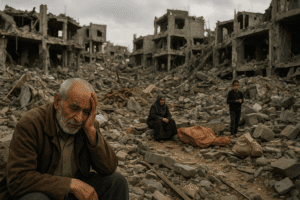Beyond the Rubble: The Unseen War on Gaza’s Most Vulnerable
The Israeli offensive has completely leveled the southern Zeitoun neighborhood of Gaza City, destroying over 1,500 homes and cornering displaced civilians under relentless bombardment. This physical destruction is matched by a profound human crisis, where a UN staff member’s 19 forced displacements exemplify a terrifying cycle of flight and impermanence. A man-made famine is carving away lives, with the elderly like Riyad al-Ghazali starving to death, their bodies reduced to skin and bone from a devastating lack of food and aid.
The international community, except for the United States, has unanimously declared this famine a preventable catastrophe. This isolation of key allies occurs as post-war planning proceeds without Palestinian representation, signaling a deeply contested future. Ultimately, the conflict has systematically dismantled every pillar of society—home, sustenance, and dignity—reducing existence to a mere struggle for survival amid unimaginable loss.

Beyond the Rubble: The Unseen War on Gaza’s Most Vulnerable
The news from Gaza often comes in a torrent of staggering numbers: 1,500 homes demolished in a single neighborhood, over 62,000 killed, countless others displaced. These figures are so vast they can become abstract, numbing us to the individual human realities they represent.
But behind every number is a story. And in the southern Zeitoun area of Gaza City, where reports confirm no building remains standing, the stories are of a profound, grinding exhaustion—a war not just on infrastructure, but on the very essence of human resilience.
The Unthinkable Reality of 19 Displacements
Imagine being forced to flee your home. Now imagine doing it 19 times in less than two years.
This is not a hypothetical scenario but the lived experience of a UNRWA staff member in Gaza, as reported by the agency. Each displacement order, each new bombardment, forces families—often with little more than the clothes on their backs—to abandon whatever fragile shelter they had found, running toward an ever-shrinking and increasingly perilous “safe zone.”
This constant cycle creates a deep-seated trauma of perpetual impermanence. There is no time to recover, no safe space to mourn, no corner of the enclave where the sound of explosions doesn’t dictate the next move. It’s a deliberate erosion of stability, making the simple, profound need for place a luxury of the past.
The Silent War on the Elderly
While bombs level buildings, a slower, quieter violence is taking a devastating toll on a particularly vulnerable group: Gaza’s elderly.
In an exclusive account, Al Jazeera documented the story of Riyad al-Ghazali. His wife, Nadia, describes a man transformed by hunger, his body whittled down from 172 pounds to a mere 92. “Look at what has become of me,” Riyad says, his voice likely echoing the despair of thousands. “My hands used to be full and strong; now they’re just skin and bone.”
Their reality is a half-loaf of bread shared, or sometimes, just salt for dinner. In nursing homes, the situation is equally dire. Caregivers, with nothing to offer, have watched five elders succumb not to bombs, but to starvation in recent months—a stark, man-made conclusion to long lives.
This targeting of the elderly is a multiplier of tragedy. They are the living libraries of Palestinian history, the grandparents who should be surrounded by family in their final years. Instead, they are dying alone and emaciated, their wisdom and stories lost to a preventable famine.
A World Watching, A Policy of Isolation
The international community’s stance adds another layer to the crisis. This week, every member of the UN Security Council except the United States jointly declared the famine in Gaza a “man-made crisis.” This rare consensus highlights a stark global divide, isolating the key actor with the most leverage to alter the course of events.
Meanwhile, the reported involvement of figures like Jared Kushner and Tony Blair in U.S. policy meetings on “post-war plans” signals a concerning precedent. It suggests that planning for Gaza’s future is being conducted by an exclusive group of unelected former officials, seemingly without the input of Palestinians themselves. This top-down approach risks designing a future for Gaza that ignores the very people who must live in it, treating them as subjects to be managed rather than a nation to be liberated.
The Human Insight: The Erosion of Normalcy
The true value of understanding these stories lies in seeing the pattern: this conflict is systematically dismantling every pillar of a functional society.
- Home is gone: replaced by a tent in a crowded, unsafe camp.
- Sustenance is gone: replaced by a desperate search for scraps or aid that comes under fire.
- Dignity in old age is gone: replaced by a humiliating and painful withering away.
- Future planning is gone: replaced by the mere struggle to survive the next hour.
The demolition of Zeitoun’s buildings is a visible, concrete symbol of this destruction. But the invisible, human demolition—of health, of family, of hope—is the deeper, more lasting tragedy. It reveals a conflict that has moved beyond a military operation into a profound humanitarian collapse, where the greatest casualty may be our collective humanity itself.
You must be logged in to post a comment.